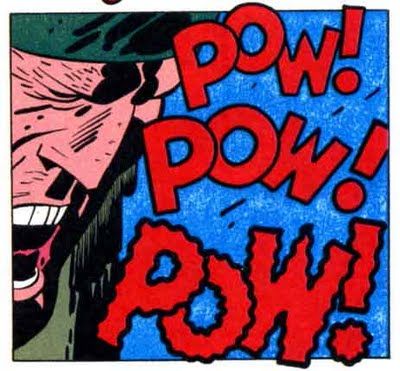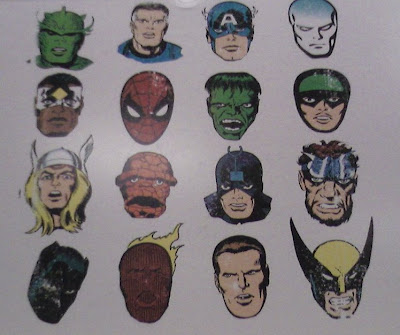The fourth and final volume of Jack Kirby's Fourth World Omnibus suggests the editorial staff at DC are either far ballsier, craftier, or more ignorant of the material than I thought: although printing four titles in the order of their publication (instead of grouping them by title) did a superb job of initially highlighting Kirby's protean imagination, reading the first 250 pages of the fourth volume is like watching the weakening death throes of a formerly-powerful animal: it's awesome in a truly depressing way.
The schema had been problematic before Volume Four: the arrangement strips the first seven issues of Forever People--basically one sprawling epic on its own--of any momentum, putting seventy pages of material between one cliffhanger and another. But considering the second volume, where this frustrated the most, also showcased a creator working at arguably the highest and final peak of his long career, the frustration was easier to dismiss. And although the problem disappears entirely in the final volume--both the Forever People and New Gods end in the first seventy-eight pages, leaving the final six issues of Mister Miracle to run consecutively--a far worse one takes its place: I would rank those final six issues of Mister Miracle as among some of the worst things Kirby's done.
Now, a statement like that requires a buttload of caveats--not only is there a ton of Kirby material I haven't read, but I'd rank the worst Kirby material as far above the worst material other writers and artists have produced in the field. Indeed, taken on their own, the issues reprinted consecutively in this Omnibus have a ton of charm. One of the pleasures of late-period  Kirby is recognizing the familiar formulas while still being surprised by whatever crazy-ass shit the man decides to throw in there--it's a lot like watching a great blues guitarist tackle a classic piece. So, for example, I initially was delighted by Mister Miracle #14 where Mister Miracle and Oberon go walking in the woods and randomly encounter a crazed Satanic cult. It follows a standard pulp plot of "high-tech crooks posing as supernatural forces to scare off trespassers" but Kirby cranks the whole thing up past 11: Satan gets mentioned as often as three times a page in the first half of the book, the cultists wear impressively grotesque masks, and until Mister Miracle does his patented next-to-last page reveal of his face (and a panel or two of P.R. man Ted Brown smoking a pipe), the most normal looking person in the book is Oberon the dwarf. The whole thing is a bit like someone had tricked Fellini into directing an episode of Scooby-Doo.
Kirby is recognizing the familiar formulas while still being surprised by whatever crazy-ass shit the man decides to throw in there--it's a lot like watching a great blues guitarist tackle a classic piece. So, for example, I initially was delighted by Mister Miracle #14 where Mister Miracle and Oberon go walking in the woods and randomly encounter a crazed Satanic cult. It follows a standard pulp plot of "high-tech crooks posing as supernatural forces to scare off trespassers" but Kirby cranks the whole thing up past 11: Satan gets mentioned as often as three times a page in the first half of the book, the cultists wear impressively grotesque masks, and until Mister Miracle does his patented next-to-last page reveal of his face (and a panel or two of P.R. man Ted Brown smoking a pipe), the most normal looking person in the book is Oberon the dwarf. The whole thing is a bit like someone had tricked Fellini into directing an episode of Scooby-Doo.
Unfortunately, just three issues later, Mister Miracle, Big Barda, and protege-in-tow Shilo Norman check into a mysterious hotel after their car breaks down and what follows hits most of the same beats as issue #14. Considering that issue comes on the heels of a story where Jack uses the infamous "it was all a dream--or was it?" cliche, the middle stretch of Omnibus Vol. 4 reads like a talented but inattentive creator running out the clock. And even before then, I'll admit Kirby had already turned Mister Miracle into pretty rote stuff, despite tossing in first Big Barda and then the rest of the Female Furies as a supporting cast. Every issue opens up with Mister Miracle performing a trick while everyone around him freaks out, and nearly every fight scene features a moment focusing on on a villain performing a can't-miss killing move on M.M. only to then look around in dismay when the smoke has cleared and there's no body to be seen. (And later issues have variations on the same panel where Scott Free removes his mask at the end and we see the circuitry he's built into it--it actually looks more like Scott has sneezed up pieces of a mother board to me). In my long-ago review of Vol. 1, I'd suggested that Mister Miracle represented a dream image of Kirby himself as creator and freelancer--"a man raised in the violent war-state of Darkseid's brutal society who is not himself violent or brutal and who supports himself and enlightens others by freeing himself again and again" is t he way I put in my review. If so, perhaps it's not wrong to see in those final issues a frustration on Kirby's part with the Mister Miracle concept as the cancellation of his other Fourth World books revealed that self-image for the dream it was: in each issue Mister Miracle's victory feels a little more hollow and far-fetched ("I suppose you that you have a gimmick that opened a slit in its hull!" is one of the more detailed explanations given for a deathtrap escape, to which Mister Miracle helpfully clarifies, "That's how I escaped!") until in the last issue he doesn't really win at all. The last issue of Mister Miracle--and what Kirby must've thought was to be the last issue of the Fourth World Saga--ends with Darkseid summing up (the issue and perhaps the entire saga), "It had deep sentiment--yet little joy. But--life at best is bittersweet!" All things considered, it's actually a pretty cheery take on things from a man helpless to stop his epic vision from being cut short. And if that had been the end of things, the end of the Omnibus, this review would go on to chastise DC for cynically choosing the publication format they did, for frontloading the great stuff at the beginning and sticking the bad stuff at the end and keeping readers from having a real choice as to what material they could buy.
he way I put in my review. If so, perhaps it's not wrong to see in those final issues a frustration on Kirby's part with the Mister Miracle concept as the cancellation of his other Fourth World books revealed that self-image for the dream it was: in each issue Mister Miracle's victory feels a little more hollow and far-fetched ("I suppose you that you have a gimmick that opened a slit in its hull!" is one of the more detailed explanations given for a deathtrap escape, to which Mister Miracle helpfully clarifies, "That's how I escaped!") until in the last issue he doesn't really win at all. The last issue of Mister Miracle--and what Kirby must've thought was to be the last issue of the Fourth World Saga--ends with Darkseid summing up (the issue and perhaps the entire saga), "It had deep sentiment--yet little joy. But--life at best is bittersweet!" All things considered, it's actually a pretty cheery take on things from a man helpless to stop his epic vision from being cut short. And if that had been the end of things, the end of the Omnibus, this review would go on to chastise DC for cynically choosing the publication format they did, for frontloading the great stuff at the beginning and sticking the bad stuff at the end and keeping readers from having a real choice as to what material they could buy.
But, of course, that wasn't the end for the Fourth World Saga. In 1984 and '85, Kirby was given the chance to come back and create an ending in the form of The Hunger Dogs, an original graphic novel, along a forty-seven page prelude titled "Even Gods Must Die!" that bridged the original stories and the graphic novels. We get apologies for the material both in the front with Paul Levitz's intro ("[F]or if the Hunger Dogs is neither the ending Jack originally hoped to do nor crafted with the same sure hand as had a decade earlier, it is still noble to try[.]") and Mark Evanier's afterword ("Jack gave it his all. Jack gave everything he did his all but he really put his heart and soul into this one, and ordinarily it would have been more than enough...but with all the problems, especially the short page count, it wasn't enough," as well as "Finally, The Hunger Dogs was published. I wish I could tell you that it was everything Kirby fans had been expecting by way of a Fourth World conclusion, but it really wasn't that. For one thing, the Fourth World wasn't concluding. For another, Jack still didn't have the thousand or so more pages it might have taken for him to build his story to the kind of climax he'd imagined.") It's safe to say the current take on this final work is not favorable.
And that's a shame. Because I found those final hundred-plus pages to be absolutely brilliant, some of the most stunning stuff Kirby's ever done. I've had The Fourth World Omnibus Vol. 4 for maybe three weeks now, and every night for the first two I'd read those last 100-plus pages again and again.
It's probably because I didn't follow Kirby after he left Marvel in the late '70s, but "Even Gods Must Die!" shocks me in its departure from earlier Kirby work: It's brasher, bolder, nearly a caricature of itself, but Kirby reframes action in ways I hadn't seen in his work since the '40s and '50s: circular inset panels, arrhythmic action scenes with arrows, confrontations where the panel borders run diagonally, making the tension of the scene literally explicit. Months ago, when reading Tezuka's Buddha, I found myself in awe of Tezuka's willingness to experiment with a page so late in his career and wondered if doing so made him a better artist than Kirby. Here, if only for a few pages, is Kirby breaking his patterns, moving finally from the blues to jazz.
Even better, the change suits the story: the circular panels reinforce the circularity of the story as Orion finally brings the battle to Darkseid, and father and son battle as a prophecy has foretold. The characters themselves are encased in circular panels, at many points appearing trapped, just as they're stuck in the cyclical nature of myth. This is something Kirby nicely underlines in his writing--in the early chapters of the New Gods, Darkseid is likened to a tiger, but in "Even Gods Must Die," that same comparison is made about Orion. If Mister Miracle was Kirby as he imagined himself to be in the '70s, the Orion of the Omnibus' final pages is the man Kirby finally realized himself to be: a man incapable of giving up, powered by a terrifying, inexhaustible anger, an anger that allows him to claw his way to the truth.
What really killed me was the scene in which Darkseid, after watching the behavior of the revivified men he's gained the power to resurrect, says to a lackey, "They don't fully return...do they?" If you think about it, that's a tremendously ballsy thing for an author to put in a story he's finishing after a decade-long absence. Kirby is speaking to the audience through Darkseid and openly telling them: "You know what? This doesn't work." In that regard, what seems like every other faux-Stan Lee title you've ever read, "Even Gods Must Die!" is in fact an apt summation of the story's point: Things are supposed to end. For most of us, that's a hard-earned truth. For a superhero comic, that's heresy.
revivified men he's gained the power to resurrect, says to a lackey, "They don't fully return...do they?" If you think about it, that's a tremendously ballsy thing for an author to put in a story he's finishing after a decade-long absence. Kirby is speaking to the audience through Darkseid and openly telling them: "You know what? This doesn't work." In that regard, what seems like every other faux-Stan Lee title you've ever read, "Even Gods Must Die!" is in fact an apt summation of the story's point: Things are supposed to end. For most of us, that's a hard-earned truth. For a superhero comic, that's heresy.
Like "Even Gods Must Die!", The Hunger Dogs is a victory stolen from the jaws of defeat and loss, and the irony is this victory is accomplished by open acknowledging defeat and loss. In The Hunger Dogs, Darkseid sees his coming obsolescence in the face of The Micro-Mark, the digitized destroyer that is the brutal male successor to the kindly Mother Box. In a staggering page, Darkseid listens to the Micro-Mark's inventor crow about the passing of Himon and wordlessly realizes that his own time has also passed. "His day is over, great Darkseid!" the collaborator boasts. "Regard him as a pitiful, harmless object! This is Micro-Mark's hour! There's no need for intrigue or great strivings--the cosmos lies open to button-pushing babes!"
 (Oh, and by the way? Holy. Fucking. Shit. It's one thing for writers, artists, photographers, and musicians these days to complain about the digital age having opened doors in their fields at the cost of lowered standards. It's another thing entirely to do it in nineteen-eighty-fucking-five. Fans of the prescient will also appreciate how both Darkseid and Lightray use suicide bombers to take out their enemies, the planet-destroying dirty bombs planted surreptitiously on New Genesis, and how Highfather turns such a terrorist attack back in on itself.)
(Oh, and by the way? Holy. Fucking. Shit. It's one thing for writers, artists, photographers, and musicians these days to complain about the digital age having opened doors in their fields at the cost of lowered standards. It's another thing entirely to do it in nineteen-eighty-fucking-five. Fans of the prescient will also appreciate how both Darkseid and Lightray use suicide bombers to take out their enemies, the planet-destroying dirty bombs planted surreptitiously on New Genesis, and how Highfather turns such a terrorist attack back in on itself.)
I was raving to Graeme about all this the other day and he put it best: The Hunger Dogs is the work of an old man, possessing an old man's wisdom and an old man's sorrow. (I don't want to give away the identity of the Micro-Mark's creator, but I will say it's pretty easy to see past the origin presented and infer disgust on Kirby's part at the way the baby boomers--his beloved New Gods--grew up and sold out.) And while Kirby may have dreamed of an epic finish to his epic saga (the conclusion he sketches out here has to settle for evoking Moses leading his people out of Egypt), I found the climax to The Hunger Dogs more satisfying, truer to life: some things change, and many things don't. Although we're told Darkseid takes control of Apokolips again, our last glimpse of him is a figure made lonely and small by distance and time: even through the anger, the scorn, and the violence, Kirby evinces pity for the most horrible of his characters.
It's a good lesson to take from the Fourth World Omnibus, for although these four volumes are a tremendous achievement and will occupy a prized place on my bookshelf, it's meaningful they sit below Buddha, the three thousand page epic Tezuka created at roughly the same time in the manner the artist wanted, at the pace he preferred (collected in hardcover in America, it should be pointed out, before The Omnibus). It achieves very little to focus only on the shame of such a thing. And yet, to look at the whole of Kirby's achievement and see only the wonder, and not the warning, would only compound the shamefulness further: the compromises presented in the final volume of The Fourth World Omnibus mirror the compromises a reader must suffer in seeing such Excellent work simultaneously transcend, and fall victim to, the paucity of its era.

 Yes, a bit later but still better than never, and maybe a good way to beat the San Diego blues? That's certainly one way to describe our conclusion to Wait, What? Episode 48. Another way to describe it might be to mention that it's almost 70 minutes long, and in it Graeme McMillan and I talking Batman, Inc. #7, Dark Horse Presents #1 and #2, Witch Doctor #1, The Creeper Omnibus, the founders of continuity and their later careers, Marvel's Iron Age miniseries, and Firestorm: The Nuclear Man, along with all the usual digressions and what-have-yous you might expect from us.
Yes, a bit later but still better than never, and maybe a good way to beat the San Diego blues? That's certainly one way to describe our conclusion to Wait, What? Episode 48. Another way to describe it might be to mention that it's almost 70 minutes long, and in it Graeme McMillan and I talking Batman, Inc. #7, Dark Horse Presents #1 and #2, Witch Doctor #1, The Creeper Omnibus, the founders of continuity and their later careers, Marvel's Iron Age miniseries, and Firestorm: The Nuclear Man, along with all the usual digressions and what-have-yous you might expect from us.

















